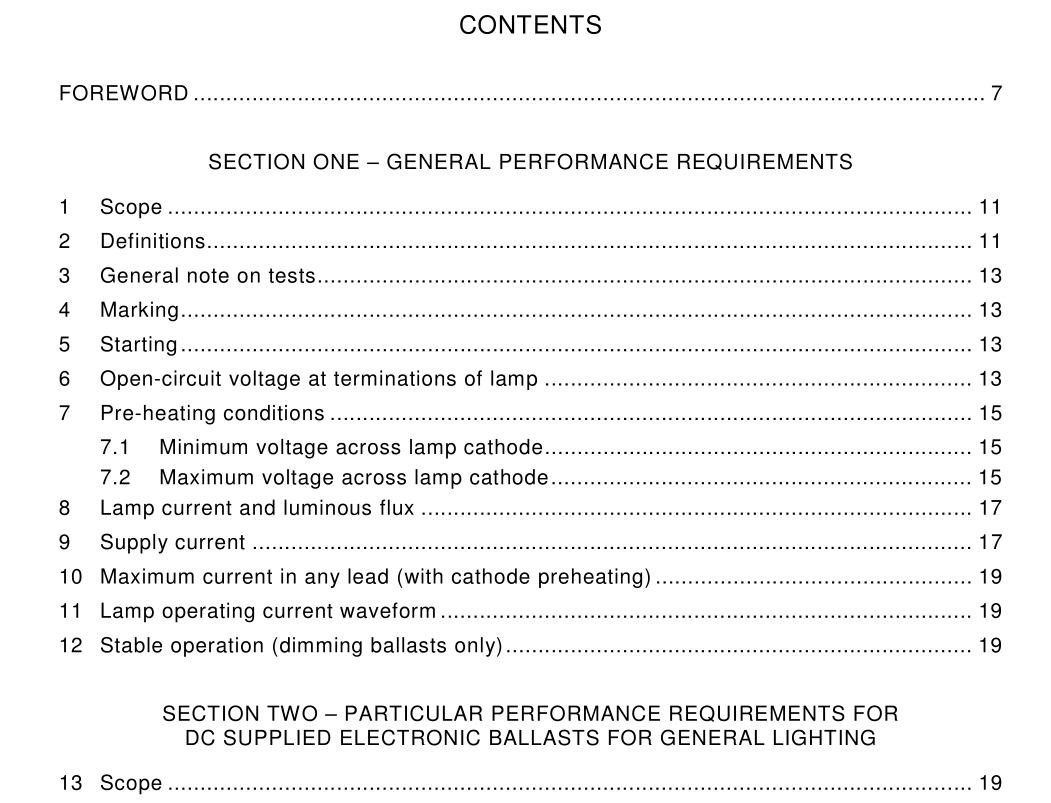IEC 60925 pdf download

IEC 60925 pdf download.DC supplied electronic ballasts for tubular fluorescent lamps – Performance requirements
1 Scope
This standard specifies general performance requirements for electronic ballasts for use on d.c. supplies having rated voltages not exceeding 250 V, associated with fluorescent lamps complying with IEC 60081. It shall be read in conjunction with IEC 60924. Performance requirements for electronic ballasts for general, public transport and aircraft lighting are specified in Sections Two, Three and Four of this standard. NOTE 1 In order to obtain satisfactory performance of fluorescent lamps with d.c. supplied electronic ballasts, it is necessary that certain features of their designs be properly co-ordinated. It is essential, therefore, that specifica- tions for them be written in terms of measurement made against some common base-line of reference, which must be reasonably permanent and reproducible. NOTE 2 These conditions may be fulfilled by reference ballasts. Moreover, the testing of ballasts for fluorescent lamps will, in general, be made with reference lamps and, in particular, by comparing results obtained on such lamps with ballasts to be tested and with a reference ballast as specified in IEC 60921.
2 Definitions
2.1 starting aid either a conductive strip affixed to the outer surface of a lamp, or a conductive plate which is spaced an appropriate distance from a lamp. A starting aid can only be effective when it has an adequate potential difference from one end of the lamp 2.2 ballast lumen factor the ratio of the light output of the lamp when the ballast under test is operated at its design voltage, compared with the light output of the same lamp operated with the appropriate reference ballast supplied at its rated voltage and frequency 2.3 reference ballast a special inductive-type ballast designed for the purpose of providing comparison standards for use in testing ballasts, and for the selection of reference lamps. It is essentially characterized by a stable voltage-to-current ratio, which is relatively uninfluenced by variations in current, temperature and the magnetic surroundings (see annex B) 2.4 symmetrical inverter a definition is under consideration 2.5 asymmetrical inverter a definition is under consideration
3 General note on tests
Tests shall be made under the conditions specified in annex A. All ballasts specified in this standard shall comply with the requirements of IEC 60924. Conformity with IEC 61547 may be declared by the manufacturer and need not form part of third party approval to this standard.
4 Marking
Non-mandatory information which may be made available by the manufacturer: a) Ballast lumen factor. b) Rated output frequency (at the design voltage, with and without the lamp operating). c) Limits of the ambient temperature range within which the ballast will operate suitably at the declared rated voltage range.
5 Starting
It may be expected that ballasts complying with this standard, when associated with lamps which comply with IEC 60081, will provide satisfactory starting (not hot restarting) of the lamp with an air temperature immediately around the lamp of between 10 °C and 35 °C at the minimum of the rated voltage range; and operation between 10 °C and 50 °C at other voltages within the rated voltage range.The lamp electrical characteristics, on the lamp data sheets in IEC 60081, apply to lamps operated with a reference ballast at its rated voltage, in an ambient temperature of 25 °C. Ballasts shall provide reliable starting of the appropriate lamps over the limits of the ambient temperature range declared by the manufacturer. Compliance is checked by the tests of clauses 6 and 7 unless evidence of satisfactory lamp life can be given by the manufacturer.
6 Open-circuit voltage at terminations of lamp
A ballast when operated at any voltage within its rated voltage range shall provide an open- circuit voltage at the lamp terminations such that: a) the minimum r.m.s. voltage across the lamp is at least that shown in the third column of table 1; b) the peak voltage across the lamp does not exceed that shown in the fourth or fifth column of table 1; c) the minimum peak voltage from one end of the lamp to the starting aid shall be at least that shown in the sixth column of table 1.









